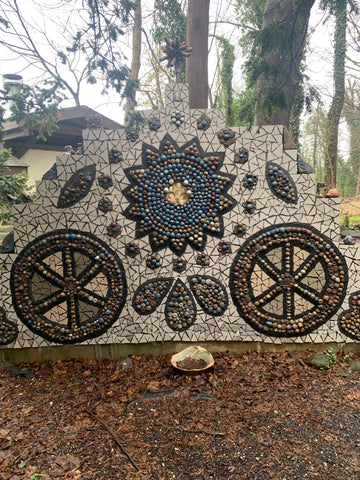Potter Robert Deane: An Intimate Approach
Potter Robert Deane: An Intimate Approach

While all artists have a personal relationship with the materials of their craft, potters share a special bond with clay that spawns a visceral connection to the earth. Southwestern Pennsylvania Potter Robert Deane brings this intimate dynamic to his work – in the clay he digs and refines, in the collaborative projects he undertakes, and especially in the philosophy of his teaching practices. This Media, PA artist teaches adults and children at the Wallingford Art Center outside of Philadelphia.
Deane earned a B.A. in Art at Bloomsburg University in 1988 and returned home to Southeast PA where he took classes at Wallingford and began to develop his work. He joined the Potter’s Guild and showed his work in the semi-annual exhibitions. He soon was teaching children’s classes at Wallingford and in 1991, he became the live-in caregiver at the art center. “It allowed me to develop an intimate relationship there,” Deane explains. “There was no commute to take up my time; I was paid just to be there, which was perfect. It gave me the time and resources to work, along with a small livable income.” By 2000, he was teaching both children and adults.



Deane’s teaching philosophy is unique and carefully crafted. “I try to put myself in the place of the student and ask what I would want in a teacher,” he explains. “If I were 9 years old, or 12 years old, what would I want? What was I like at that age? Maybe I would have liked to watch, maybe share a creative moment. This could be very different from what I would want if I were an adult.” Deane says that when he was learning to throw, he wanted a hands-on experience with his instructor. This one-on-one approach is part of his method today. “I work for a full hour each week with each new student,” he says. “There are so many subtle things you can pick up on with this level of attention. Even in glazing, I like to work one-on-one, showing the variations of the thickness of application, the use of tongs, the combination of glazes, and the necessary quantity of wax, for example.” He engages the adults in critique, pulling the most interesting pieces from the twice-weekly kiln firings for class discussion.
Deane began digging local clay near his home and near the art center many years ago. He was inspired by Mimi Obstler's Out of the Earth, Into the Fire, which he read in the late 1990s. He began to acquire the  equipment needed – a pug mill, 30-gallon drums, stainless steel mesh – and started to “understand what the clay needed me to give it.” He dilutes the clay with water and sifts the larger stones and twigs before he adds leftover clay from the art center. “We have these large slop buckets for tool washing. It’s a mix of every clay body we use,” he explains. Once the clay is mixed, he makes a test “finger,” which he fires to cone 10. “It tells me how I need to cut it for melting temperature, plasticity, and content,” he says. “Every clay is beautiful and waiting to shine.”
equipment needed – a pug mill, 30-gallon drums, stainless steel mesh – and started to “understand what the clay needed me to give it.” He dilutes the clay with water and sifts the larger stones and twigs before he adds leftover clay from the art center. “We have these large slop buckets for tool washing. It’s a mix of every clay body we use,” he explains. Once the clay is mixed, he makes a test “finger,” which he fires to cone 10. “It tells me how I need to cut it for melting temperature, plasticity, and content,” he says. “Every clay is beautiful and waiting to shine.”
Deane’s work with children is entwined with his development of clay bodies from local creek clay. He says that he was always in the creek as a child and applies this self-understanding to his current young students. He takes his students outside – for a walk to the pond, to catch frogs and worms, to slop in the mud. “A child might be a little shy or reluctant, but a week later, that will be a memory that will not be forgotten,” he says. He admits to eating seven or eight worms every class semester. He always has a group of boys who love to dig, to find the clay under the top 18 inches of soil. He finds that these are the students who have a hard time sitting still and working in a chair but are able to do so more readily after the outdoor foray.

The relationship that he builds with his young students bear fruit in collaborative work. With his colleague Drew Arate, Deane has led children in creating several installations on the art center property. A group made tiled chairs and a table that was placed under a large evergreen, creating an outdoor classroom/workplace. Another project established a community of mini castles. Later, a large castle constructed of clay tubes was added, to serve as the town center. The most recent project is an installation of “brain balls,” balls of clay no larger than golf balls that are mosaiced on a 7x10 foot cinderblock triangular stanchion. Each of these projects continues to evolve. Many of the child artists return to the center’s summer camp every year and have worked on them over time.

Deane says, “Art doesn’t have a beginning or an ending. There are always new possibilities.” The children gather at the sites and share stories about their “worm-opolis,” where millipedes and rollie-pollie bugs go about their days. New items are added; the arrangement is altered. “This world,” Deane says, “has been birthed through our hands into something beautiful and tactile.” Certainly, Deane, in his decades-long connection to clay, has birthed something beautiful and life-changing for his students.
See more at www.bobdeanepottery.com and www.communityartscenter.org
